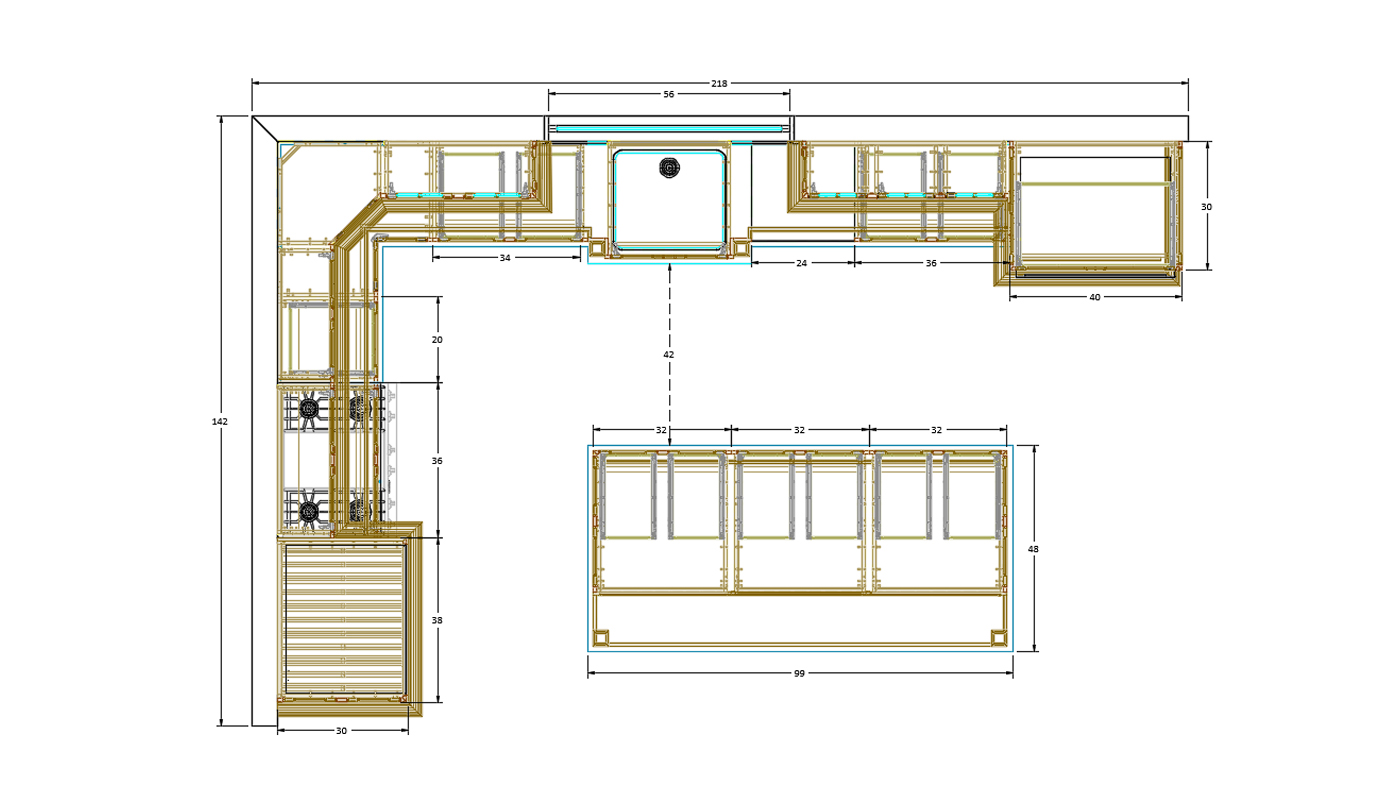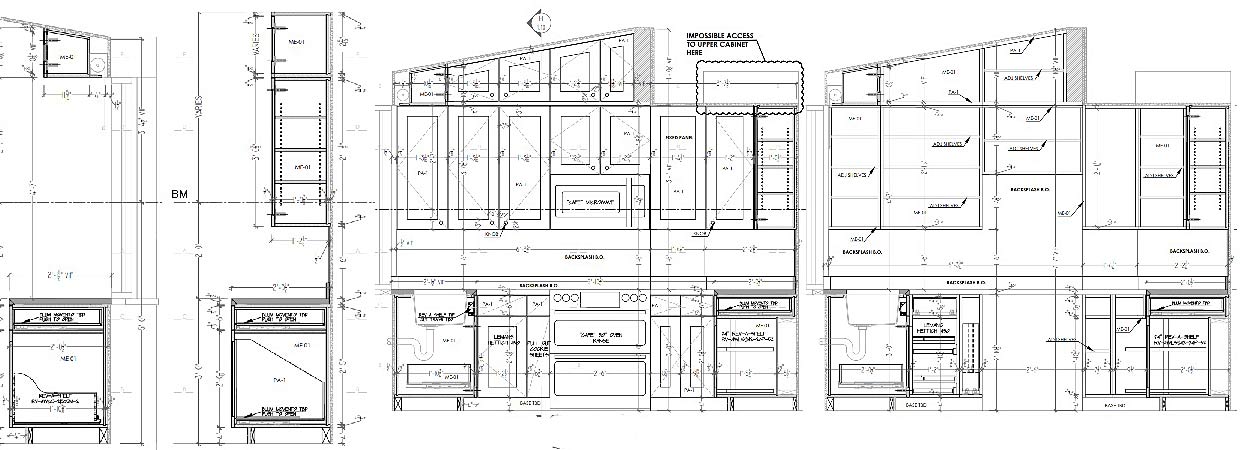Kitchen Cabinet Planning Basics

Kitchen cabinet planning is a crucial aspect of any kitchen remodel or new construction project. It’s not just about choosing the right cabinets, but about designing a functional and aesthetically pleasing space that meets your specific needs and preferences. Well-planned kitchen cabinets can maximize storage, improve workflow, and enhance the overall look and feel of your kitchen.
Types of Kitchen Cabinet Plans, Kitchen cabinet plan cad blocks
Different types of kitchen cabinet plans cater to various needs and preferences. Understanding these options helps you choose the best fit for your kitchen.
- Traditional Kitchen Cabinet Plans: These plans feature a classic, symmetrical layout with upper and lower cabinets arranged in a traditional fashion. They are often found in older homes and offer a timeless aesthetic.
- Contemporary Kitchen Cabinet Plans: These plans embrace modern design elements, often featuring sleek lines, minimalist details, and open shelving. They are ideal for creating a clean and uncluttered look.
- Transitional Kitchen Cabinet Plans: These plans blend traditional and contemporary styles, offering a balanced approach. They incorporate classic features with modern accents, creating a versatile and timeless design.
Creating a Basic Kitchen Cabinet Plan
Creating a basic kitchen cabinet plan involves several steps, starting with gathering information and measurements to ensure an accurate representation of your kitchen space.
- Measure Your Kitchen Space: Accurate measurements are essential for creating a functional and visually appealing kitchen cabinet plan. Measure the length, width, and height of each wall, including any windows, doors, or other obstacles.
- Determine Your Kitchen Layout: Consider the placement of appliances, the location of the sink, and the overall flow of traffic in your kitchen. This helps you visualize how cabinets will be arranged.
- Choose Cabinet Styles and Sizes: Select cabinet styles and sizes that meet your storage needs and complement the overall design of your kitchen. Consider factors like cabinet depth, door styles, and finish options.
- Create a Floor Plan: Draw a simple floor plan of your kitchen, marking the location of walls, doors, windows, and appliances. Use this plan to sketch in the placement of cabinets.
- Consider Work Triangle: The work triangle refers to the space between the sink, stove, and refrigerator. Ideally, this triangle should be between 4 and 26 feet for optimal efficiency and ease of movement.
- Think About Storage Needs: Analyze your storage needs based on your cooking habits and the items you need to store. This helps you determine the number and type of cabinets required.
Using CAD Blocks for Kitchen Cabinet Design: Kitchen Cabinet Plan Cad Blocks

Designing a kitchen can be a complex task, involving multiple factors like space utilization, functionality, and aesthetics. This is where using CAD blocks can be a game-changer for kitchen cabinet design. CAD blocks are pre-drawn, customizable components that can be easily inserted and manipulated in your CAD software, making the design process more efficient and accurate.
Benefits of Using CAD Blocks for Kitchen Cabinet Design
CAD blocks offer a plethora of benefits that streamline the design process and elevate the quality of your kitchen cabinet plans.
- Save Time and Effort: Instead of manually drawing each cabinet, countertop, and appliance, you can simply insert pre-designed blocks, significantly reducing design time.
- Enhance Accuracy: CAD blocks are precisely drawn to scale, ensuring accurate dimensions and proportions in your kitchen layout. This eliminates potential errors that can arise from manual drafting.
- Promote Consistency: Using standardized blocks ensures consistency in design elements like cabinet sizes, door styles, and drawer configurations. This creates a cohesive and professional look.
- Simplify Revisions: Making changes to your design is effortless with CAD blocks. You can easily modify the size, position, or style of any element by simply editing the block.
- Facilitate Communication: Sharing your CAD plans with clients or contractors is made easier with blocks. They provide a clear and detailed visual representation of the design, minimizing misunderstandings.
Essential CAD Blocks for Kitchen Cabinet Planning
To create a comprehensive kitchen cabinet layout, you’ll need a collection of essential CAD blocks that represent the key components of your design.
- Cabinet Blocks: This is the core of your kitchen design. You’ll need blocks for various cabinet types like base cabinets, wall cabinets, tall cabinets, corner cabinets, and specialty cabinets.
- Countertop Blocks: Include blocks for different countertop materials like granite, quartz, laminate, and butcher block.
- Appliance Blocks: Represent appliances like refrigerators, ovens, dishwashers, microwaves, and ranges with accurate dimensions and placement.
- Sink and Faucet Blocks: Ensure you have blocks for various sink styles and faucet designs.
- Hardware Blocks: These blocks represent handles, knobs, hinges, and other hardware components for a complete design.
- Lighting Blocks: Include blocks for different types of kitchen lighting like pendant lights, recessed lights, and under-cabinet lights.
- Wall and Floor Blocks: Represent the walls and flooring of your kitchen with appropriate materials and textures.
- Decorative Blocks: Use blocks for decorative elements like backsplashes, trim, moldings, and crown molding.
Creating a Detailed Kitchen Cabinet Layout with CAD Blocks
Using CAD blocks, you can create a detailed kitchen cabinet layout that accurately reflects your design vision. Here’s a step-by-step guide:
- Start with the Room Layout: Begin by creating the basic Artikel of your kitchen space using wall and floor blocks.
- Place Major Appliances: Insert blocks for your major appliances like refrigerators, ovens, and dishwashers, ensuring they are positioned correctly based on their dimensions and functionality.
- Layout Cabinetry: Utilize cabinet blocks to create the layout of your kitchen cabinetry. Consider factors like workflow, storage needs, and aesthetics.
- Add Countertops and Sinks: Place countertop blocks to create the work surfaces in your kitchen. Include sink and faucet blocks for the designated areas.
- Incorporate Hardware and Lighting: Add hardware blocks for handles, knobs, hinges, and other decorative elements. Place lighting blocks to illuminate the kitchen space.
- Refine and Detail: Adjust the placement and configuration of your blocks to fine-tune the layout and create a visually appealing and functional design.
- Annotate and Dimension: Add annotations and dimensions to your plan for clarity and accuracy.
Advanced Kitchen Cabinet Planning Techniques

Kitchen cabinet plan cad blocks – While basic kitchen cabinet planning involves understanding dimensions and layout, mastering advanced techniques unlocks a world of functionality and aesthetic appeal. This section explores techniques that go beyond the basics, transforming your kitchen into a highly efficient and visually pleasing space.
Incorporating Ergonomic Principles
Ergonomic principles are crucial for creating a kitchen that is both functional and comfortable to use. By designing a kitchen that considers the user’s movements and body mechanics, you can minimize strain and maximize efficiency.
- Work Triangle: The work triangle is a fundamental concept in kitchen design, connecting the sink, stovetop, and refrigerator in a triangular formation. The ideal distance between these points should be between 4 and 7 feet to allow for efficient movement without feeling cramped. A well-designed work triangle ensures smooth workflow and minimizes unnecessary steps.
- Countertop Height: Countertop height is crucial for comfortable use. The standard countertop height is 36 inches, but this can vary depending on the user’s height. A countertop that is too high can lead to back strain, while a countertop that is too low can cause shoulder and neck pain. Consider adjusting the countertop height based on the average height of the users. For example, a countertop height of 34 inches might be more comfortable for someone who is 5’4″ tall.
- Storage Placement: Strategically placing frequently used items within easy reach is key. Items used daily should be stored at a comfortable height, minimizing bending and reaching. Less frequently used items can be placed in higher or lower cabinets. This maximizes efficiency and reduces unnecessary strain.
Optimizing Storage Space
Maximizing storage space is essential in any kitchen. Advanced techniques go beyond simply placing cabinets; they focus on maximizing vertical space, utilizing corners, and incorporating specialized storage solutions.
- Vertical Space: Utilizing the vertical space is crucial. Tall cabinets with pull-out shelves or drawers allow you to store items that are often forgotten about in the back of a standard cabinet. This approach creates a more efficient and organized kitchen.
- Corner Cabinets: Corners are often overlooked in kitchen design, but they offer valuable storage space. Consider incorporating lazy Susans, pull-out shelves, or corner drawers to maximize the utility of these areas. These solutions provide easy access to items stored in corners, eliminating the need to reach into awkward spaces.
- Specialized Storage Solutions: Utilize specialized storage solutions for specific items. For example, spice racks, utensil organizers, and pull-out trays for pots and pans are excellent ways to optimize storage space and enhance functionality. These solutions make it easier to find and access specific items, reducing clutter and maximizing efficiency.
Kitchen cabinet plan CAD blocks provide a detailed blueprint for your dream kitchen, but sometimes, a touch of personality is needed. For a unique and affordable makeover, consider exploring chalk paint cabinet ideas , which can transform your cabinets into a statement piece.
With the right plan and a dash of creativity, you can create a kitchen that truly reflects your style, all while utilizing the precision of your CAD blocks.
Kitchen cabinet plan CAD blocks are essential tools for designers and homeowners alike, providing detailed blueprints for creating the perfect kitchen space. When it comes to bringing those plans to life, however, you may need the expertise of companies that paint kitchen cabinets.
These professionals can transform your cabinets with vibrant colors and finishes, adding a touch of elegance and personality to your kitchen design. By carefully selecting the right paint and finish, you can enhance the overall aesthetic of your kitchen, perfectly complementing the plans you’ve meticulously crafted with your CAD blocks.
